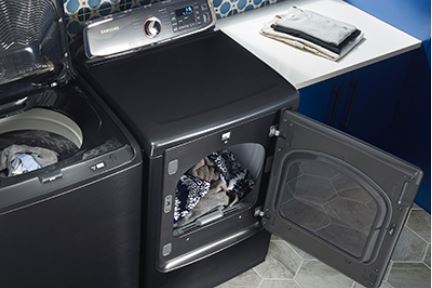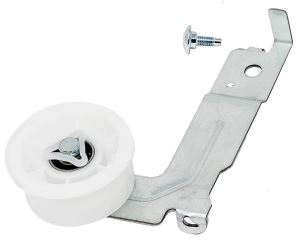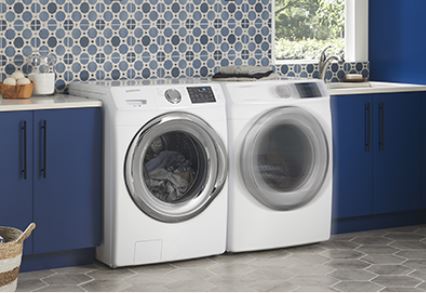You can tell a defective Samsung dryer idler pulley from the noise it produces. So, it’s best to recognize and quickly stop a Samsung dryer idler pulley noise, which often means replacing the idler pulley.
In most cases, a Samsung dryer will produce a loud squeaky (or chirping), rumbling, thumping, humming (or buzzing), or grinding sound when the idler pulley is faulty. The idler pulley could be lint-obstructed, worn out, or damaged in such cases.
Note, however, that such noises could also be a product of other issues, which I’ll highlight. So, you can’t just conclude that the idler pulley is defective because the dryer is making weird noises.
Ideally, it means inspecting the idler pulley before judging it as defective. But again, you may have to rule out some other issues before taking your dryer down to check out the idler pulley.
This guide will help you know how vital the idler pulley is, how it fails, the signs that it is defective, the various noises it may make, and how to replace it.
Let’s dive in!

In a rush? Below is a summary of the most typical Samsung Dryer idler pulley noise types you should be wary of:
Samsung Dryer Idler Pulley Noises – Quick Summary
| – | Noise Type | Other Possible Causes Besides a Faulty Idler Pulley |
| 1. | Squeaky or Chirping Sound | Laundry overload, loose feet, extra-wet laundry, loose screws, damaged hinge, faulty dryer belt, or worn-out support rollers |
| 2. | Loud Rumbling Noise | Unleveled dryer, unbalanced laundry, obstructed blower, or worn-out roller axles or support rollers |
| 3. | Thumping Noise | Dryer overload, clumping items, obstructed blower, broken belt, or worn-out support rollers |
| 4. | Humming or Buzzing Sound | Loose feet, blower blockade, faulty motor, or worn-out drum bearings, glides, or dryer belt |
| 5. | Grinding Noise | Bulky load, obstructed drum, blower blockade, or worn-out drum rollers, motor, dryer belt, or drum bearings |
What’s an Idler Pulley and What Does It Do on a Samsung Dryer?
The idler pulley is a spring-loaded tensioning device inside the dryer, which adds tension to the dryer belt. It gives the dryer belt the necessary grip and firmness to rotate the drum. So, if it fails, the drum won’t spin as it should or may fail to turn entirely.
You can locate the idler pulley at the bottom of your dryer cabinet – close to the dryer belt and motor pulley.
Signs of a Bad Samsung Dryer Idler Pulley
Overall, here are the signs of a failing Samsung dryer idler pulley:
- Belt travel – If the idler pulley is defective, the belt will lose its grip. It won’t be able to firmly grip and turn the drum. In the end, your Samsung dryer won’t spin.
- Frozen pulley – A defective idler pulley freezes. In that case, you’ll find it difficult to rotate it (by hand) manually.
- Pulley damage – You can also tell a defective idler pulley if it shows signs of physical destruction or wear. That shows it’s beyond its best years.
- Lint obstruction – Sometimes, an idler pulley fails from too much lint accumulation. So, if you notice a lot of lint around the idler pulley, then you can expect the pulley to fail.
- Loud noise – Note that I’ll discuss this in detail. Before that, it’s worth recapping what I shared: a defective Samsung dryer idler pulley can produce loud noise such as squeaking, rumbling, grinding, thumping, or humming.
How Does a Samsung Dryer Idler Pulley Fail?
After looking at the signs of a bad idler pulley, you must wonder how this internal component fails. Well, here are the most typical ways:
- Lint blockage – Over time, lint accumulates around most internal dryer components, including the idler pulley. When it does, the idler pulley loses its tension on the drive belt, affecting the drum’s spinning pattern.
- Natural wear – All dryer components, including the idler pulley, wear down over time. The idler pulley is likelier to wear down faster than most parts because it’s always involved in high-speed rotation and friction.
- Physical damage – The idler pulley isn’t immune to damage. It can also break from mishandling or any form of physical pressure.

Samsung Dryer Idler Pulley Noise Types Shared
As I mentioned earlier, a loud noise is one of the signs of a defective idler pulley. Overall, a Samsung dryer idler pulley can make a variety of noises, and below are the most common:
1. Squeaky or Chirping Sound
Sometimes, a Samsung dryer makes a bird’s chirping, squeaking, or screeching sound when the idler pulley fails. This noise typically appears initially when the idler pulley starts to die. So, it doesn’t stop the dryer from starting and running.
Once neglected, the sound could worsen, and the idler pulley could fail further and even affect the dryer belt. However, the squeaky or chirping sound could also stem from other issues, such as the following:
- Laundry overload – Your Samsung dryer may squeak or chirp if the drum is over ¾ full. That shows the clothes are overwhelming the dryer.
- Loose feet – You can expect your Samsung dryer to make some noise if its feet are loose. At times, the noise is squeaking or bird chirping.
- Extra-wet laundry – Though we expect you to load wet clothes into the dryer, the items don’t have to be soaking wet. If they are, that overworks the dryer, and it may squeal.
- Loose screws – If your Samsung dryer is pretty new and making a squeaking sound, it’s highly likely due to loose screws, which you should have fastened before using.
- Damaged hinge – The dryer door hinge could be rusty. If so, it’ll produce a squeaky sound. Sometimes, a quick lubrication fixes the issue, but if the hinge is poorly damaged, you may need to replace it.
- Faulty dryer belt – Sometimes, the dryer belt produces a similar squeaky sound as a defective idler pulley. After all, these two components are complementary.
- Worn-out support rollers – Lastly, you can expect the dryer to be noisy if the support rollers, whose job is to support the drum, wear down. They produce a variety of noises, and a squeaking sound is one of them.
2. Loud Rumbling Noise
A Samsung dryer can also produce a loud rumbling noise during the early stages of a failing idler pulley. So, consider checking the idler pulley when your dryer starts to roar.
However, just like in the first case, the idler pulley isn’t the only thing that could cause a loud rumbling sound. There are other reasons, which include the following:
- Unleveled dryer – If your dryer is out of balance, perhaps due to loose feet, it could produce a loud rumbling noise. Also, check the surface it sits as it could be uneven.
- Unbalanced laundry – If the clothes aren’t balanced in the dryer, you can expect the drum to make some noise, which could be a loud rumbling.
- Obstructed blower – The blower may accumulate lint over time, and it struggles to blow out air when it does. If so, it may make a rumbling sound.
- Worn-out roller axles or support rollers – If the roller axles or drum rollers are worn-out, they won’t support the drum as they should. Ultimately, the loose drum will make some noise, sometimes a loud rumbling.
3. Thumping Noise
Thumping is another prevalent noise associated with a failing dryer idler pulley. In such a case, the dryer sounds like something is heavily hammering against its walls and drum.
While the issue could be the idler pulley, it still could be something different, such as:
- Dryer overload – It could be that the clothes are excessive and thus won’t spin properly. So, check the drum’s capacity.
- Clumping items – It could also be that some of the clothes have tangled and formed a ball-like cluster that thumps against the dryer walls and drum.
- Obstructed blower – The dryer may also be thumping loudly because the blower is lint-obstructed and, therefore, struggling to blow hot air out.
- Broken belt – Not only can a defective belt produce a squeaking sound, but it can also produce loud thumping. Hence, inspect it.
- Worn-out support rollers – Worn-out drum rollers can also produce a thumping noise, not just a loud rumbling or squeaky sound.
4. Humming or Buzzing Sound
While the humming or buzzing sound is uncommon among Samsung dryers, it may happen due to a defective idler pulley. And if it’s not the idler pulley at fault, then it could be any of these issues:
- Loose feet – The dryer may produce a loud buzzing sound if it’s off balance, most likely due to loose feet.
- Blower blockade – Possible lint obstruction around the blower could cause a buzzing sound. So, check the blower for lint blockade.
- Faulty motor – A defective dryer motor will always be noisy, sometimes buzzing.
- Worn-out drum bearings, glides, or dryer belt – You can also expect the dryer to buzz loud if the drum bearings, glides, or dryer belt wear out.

5. Grinding Noise
A defective idler pulley could also force your dryer to make a grinding noise. And if it’s not the idler pulley, it could be any of these issues:
- Bulky load – It could be that the clothes are excessive and overwhelming the dryer.
- Obstructed drum – The drum may produce a loud grinding sound if anything is blocking the drum, perhaps loose metal objects.
- Blower blockade – The blower could have over-accumulated lint and is thus struggling to blow hot air around
- Worn-out drum rollers, motor, dryer belt, or drum bearings – One of these dryer-support components may have worn out and thus need replacing.
How Do I Fix the Idler Pulley On My Samsung Dryer?
When it comes to a defective dryer idler pulley, there is just no repair. Its only fix is a replacement, and you need the correct replacement.
One way to get a matching Samsung dryer idler pulley replacement (View on Amazon) is to consider the dryer model and the idler pulley part number.
Concluding Thought on the Samsung Dryer Idler Pulley Noise:
Above are the various noises a Samsung dryer idler pulley may make when it fails. It’s thus essential to take action fast when you recognize these. That means inspecting the idler pulley and replacing it if it’s defective. Don’t forget to consider the other issues as they could also be the reason for the weird noises.
Also Read:
